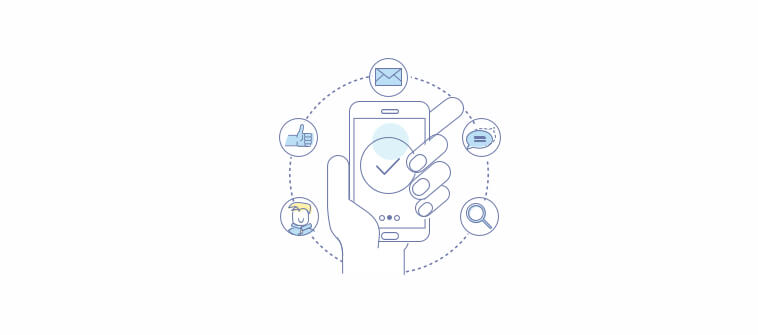Customers today have more options than ever to communicate with your brand. They can share a query via live chat, drop a feature request via email, or share their experience on social media.
As a result, it is all the more important to manage all inbound and outbound conversations using the best customer communication management practices. This way, whether a customer interacts with a sales executive or a support representative, they can have a consistent experience every single time.
In this blog, we will discover the definition of customer communication management, its types, and 5 CCM tools to help you make every conversation count.
What Is Customer Communication Management?
Customer Communications Management (CCM) is a strategic process to enhance the creation, distribution, storage, and retrieval of customer communications.
CCM involves coordinating efforts across multiple departments, such as marketing (for creating email campaigns), customer service (for providing phone assistance), and accounts (for sending billing and payment notifications).
It can help you engage in meaningful conversations, deliver consistent experiences, and foster long-term customer loyalty. You can streamline communications across various channels, including email, live chat, SMS, phone, social media, and chatbots, ensuring all interactions are cohesive and efficient.
What Are the Benefits of Effective Customer Communications Management?
Implementing the right customer communication management practices has multiple benefits, from improved CX to employee training. Let’s discuss them in detail.
1. Improve the Customer Experience
CCM can help you find answers to many important questions. For example, you can identify your audience’s most popular customer communication methods or channels. Similarly, you can even track relevant metrics, such as the average wait time for live chat, email, or the phone.
With such great insights at your fingertips, you can look to meet customer expectations and enhance the customer experience. For instance, if you see that a majority of customers prefer live chat to communicate, you can make it your primary channel and add more chat operators to meet the demand.
2. Reach Customers with Proactive Communication
Being proactive in your customer relationships can help you reduce customer frustration and, eventually, minimize customer churn. With the right customer communication management system in place, you can share proactive communications and delight customers.
Here is how you can engage in proactive communication:
- Share Regular Updates
Keeping customers informed is crucial. For example, if a customer reports a product issue without an update for two days, they will likely become frustrated. To avoid this, provide regular updates on the status of their queries or complaints.
Similarly, keep clients updated on project progress to ensure they know how your team is advancing.
- Report Unusual Activities
Unusual activities or problems can occur at any business on any day and at any time. For example, your business website can crash, or a payment gateway might fail to work.
In such cases, you need to share proactive notifications with customers to inform them about the issue. This will also save your support team from answering unnecessary phone calls or emails.
3. Enhance Employee Training
We all know that a customer communication management system can store all ongoing and past customer interactions in one place. But how can this data help your business with employee training?
Well, your team members can access this information whenever needed. More importantly, when you hire new customer-facing staff members, they can access email, phone, or chat conversations and understand the script that is followed. Managers can even identify top-rated client interactions and use them as examples to show everyone what is expected of them.
4. Gain a Competitive Advantage
Let’s be honest, not every business out there values how they communicate with customers. As a result, there is an evident lack of consistency, guiding principles, and quality in customer communications.
However, when your business follows customer communication management best practices, you can stay ahead of the competition. Customers will never have a hard time reaching out to your business for support or sales inquiries.
Furthermore, they will be happy to share their excellent experiences with family members and friends and drive more prospects to your business.
What Are the Types of Customer Communication Management?
From email to SMS, businesses use multiple channels to communicate with customers. Let’s explore them in detail.
1. Email Communication
Email communication is a fundamental component of customer communication management, providing a reliable way to interact with customers.
- Automated Emails: Pre-scheduled emails triggered by specific customer actions or events, such as welcome emails or password resets. These help maintain continuous engagement without manual intervention.
- Newsletters: Regular updates sent to customers, providing news, promotions, or content relevant to their interests. Newsletters keep customers informed and engaged with your brand.
- Customer Support Emails: Direct communication between customers and support teams for resolving inquiries and issues. They offer a personal touch and detailed responses.
2. Phone Communication
Phone communication remains a vital channel for direct and personal customer interactions, offering immediate responses.
- Inbound & Outbound Calls: Direct phone calls to and from customers for support, sales, or feedback. They offer a personal connection and immediate resolution of issues.
- Interactive Voice Response (IVR) Systems: Automated phone systems that guide customers through options and direct them to the appropriate department or resource. IVR enhances efficiency and customer self-service.
3. Live Chat
Live chat offers real-time text-based communication, providing quick and convenient support for customers.
- Website Live Chat: Real-time text-based conversations between customers and support agents on a website. Live chat offers instant support and enhances user experience.
- Chatbots and AI-Driven Conversations: Automated chatbots that use AI to answer common questions and guide customers through processes. Chatbots reduce the workload on human agents and provide 24/7 support.
4. Social Media Communication
Social media platforms are essential for engaging with customers and managing brand presence.
- Managing Customer Interactions: Engaging with customers on social media platforms like Facebook, Twitter, and Instagram to answer questions and resolve issues. Social media offers a public and responsive way to handle customer service.
- Social Media Listening and Monitoring: Tracking brand mentions and customer sentiments across social media to respond proactively. This helps in understanding customer needs and managing brand reputation.
5. SMS/Text Messaging
SMS communication provides a direct and immediate way to reach customers with important information and updates.
- Transactional Messages: Sending important information such as appointment reminders, order updates, and verification codes via text. SMS provides immediate and direct communication.
- Promotional Campaigns: Marketing messages sent via SMS to inform customers about sales, promotions, and special offers. SMS marketing has high open rates and prompt responses.
6. Web and Mobile Notifications
Web and mobile notifications effectively engage users with timely alerts and updates directly on their devices.
- Push Notifications: Short, timely messages sent directly to a customer’s device to engage them with relevant information or alerts. Push notifications help in re-engaging users and delivering critical information.
- In-App Messages: Notifications that appear within a mobile app to guide users or provide updates without interrupting their experience. In-app messages improve user experience and retention.
7. Surveys and Feedback
Collecting surveys and feedback is crucial for understanding customer satisfaction and identifying areas for improvement.
- Customer Satisfaction Surveys: Tools to gather customer opinions on products, services, and overall experience. CSAT surveys help identify areas for improvement and measure satisfaction.
- Net Promoter Score (NPS) Surveys: Short surveys that measure customer loyalty and likelihood to recommend the company. NPS provides a clear metric for customer advocacy.
- Feedback Forms: Forms that allow customers to provide detailed feedback on their experiences and interactions. Feedback forms are crucial for continuous improvement and understanding customer needs.
8. Video Communication
Video communication adds a personal and visual dimension to customer interactions, enhancing clarity and engagement.
- Video Calls & Conferencing: Real-time video interactions for support, consultations, and meetings with customers. Video communication adds a personal touch and visual clarity.
- Video Tutorials & Product Demos: Recorded videos that demonstrate how to use products or services, providing visual guidance. Videos are engaging and can be re-watched as needed.
5 Best Practices to Improve Customer Communication Management
By adopting best practices, businesses can streamline interactions, enhance customer experiences, and foster loyalty. Here are five key strategies to improve your customer communication management:
1. Leverage Multi-Channel Support
Offering support across multiple channels—such as email, phone, live chat, and social media—ensures customers can reach you through their preferred method. This accessibility improves customer satisfaction and loyalty.
According to a report by Microsoft, 66% of consumers use at least three different communication channels to contact customer service, highlighting the importance of a multi-channel approach.
Ensuring seamless integration between these channels provides a consistent and cohesive customer experience.
2. Automate Routine Inquiries
Implementing chatbots and automated response systems for common questions can significantly reduce response times and free up human agents to handle more complex issues.
Automation ensures that customers receive immediate assistance, enhancing their overall experience and satisfaction. By leveraging AI and machine learning, businesses can continually improve the accuracy and relevance of automated responses, providing efficient and effective SaaS customer support 24/7.
3. Personalize Customer Interactions at Scale
Personalizing communications based on customer data, such as purchase history and preferences, can significantly improve engagement and loyalty. Using tools and data analytics, businesses can tailor their messages to individual customers, making them feel valued and understood.
According to an Epsilon study, 80% of consumers are more likely to make a purchase when brands offer personalized experiences.
Personalization can include addressing customers by name, referencing past interactions, and offering relevant product recommendations.
4. Regularly Train and Update Your Team
Continuous customer service training and development of customer support teams are essential for maintaining high-quality service.
Regular training sessions on new tools, communication skills, and product knowledge ensure that your team is well-equipped to handle diverse customer inquiries effectively and professionally. Investing in employee development not only enhances service quality but also boosts team morale and job satisfaction, leading to lower turnover rates and a more motivated workforce.
5. Implement a Feedback Loop
Establishing a robust feedback loop allows you to continuously gather and analyze customer feedback to improve your communication with them.
According to Gartner, companies that successfully implement customer feedback loops can increase their customer retention rates by up to 25%.
Use surveys, follow-up emails, and feedback forms to understand customer experiences and identify areas for improvement.
Actively addressing feedback demonstrates to customers that their opinions are valued and helps foster a culture of continuous improvement within your organization.
FREE. All Features. FOREVER!
Try our Forever FREE account with all premium features!
Top 5 Customer Communication Management Software
Now it’s time to explore 5 market-leading tools that make managing customer interactions a breeze.
1. ProProfs Help Desk
Whether it is email, live chat, chatbots, or web forms, ProProfs Help Desk allows you to track all your inbound and outbound customer communications in one place.
With AI-powered capabilities, you can understand the customer’s intent and respond faster with auto-generated response suggestions. In addition, ProProfs Help Desk allows you to encourage self-service via a knowledge base. Your team members can collaborate to create, edit, and publish self-help content.
Top Features of ProProfs Help Desk:
- Internal notes facilitate real-time collaboration between team members
- Proactive chat invitations can be shared with visitors based on the time spent on a webpage
- The customer portal allows customers to track the progress of their ongoing tickets
- Email surveys can be triggered at the right time to capture feedback
Pricing:
FREE for a single user. Plans start at $19.99/user/month for 2 or more users. No hidden fees. A 15-day money-back guarantee.
2. Zendesk
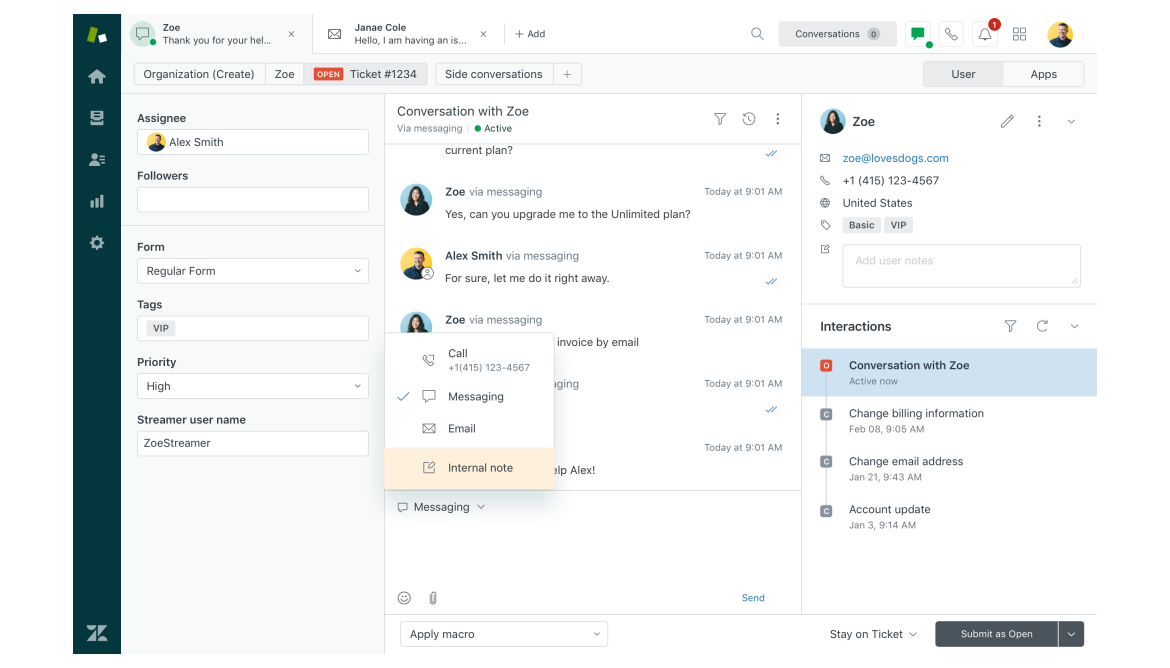
Image Source: Getvoip.com
Zendesk is a popular customer communication solution that allows you to have seamless conversations across channels so that customers don’t have to repeat themselves.
With relevant customer data at hand, your team can deliver personalized conversations at scale. Moreover, with the help of intelligent answer bots, you can offer 24×7 assistance to customers even when your team is not available to take chats.
Top Features of Zendesk:
- All social media interactions on Facebook and WhatsApp can be managed centrally
- Community forum to allow customers to interact with each other
- Proactive notifications to drive engagement and prevent escalations
- Online help center allows customers to find answers at their own pace
Pricing:
Starts at 55/user/month
3. LiveAgent
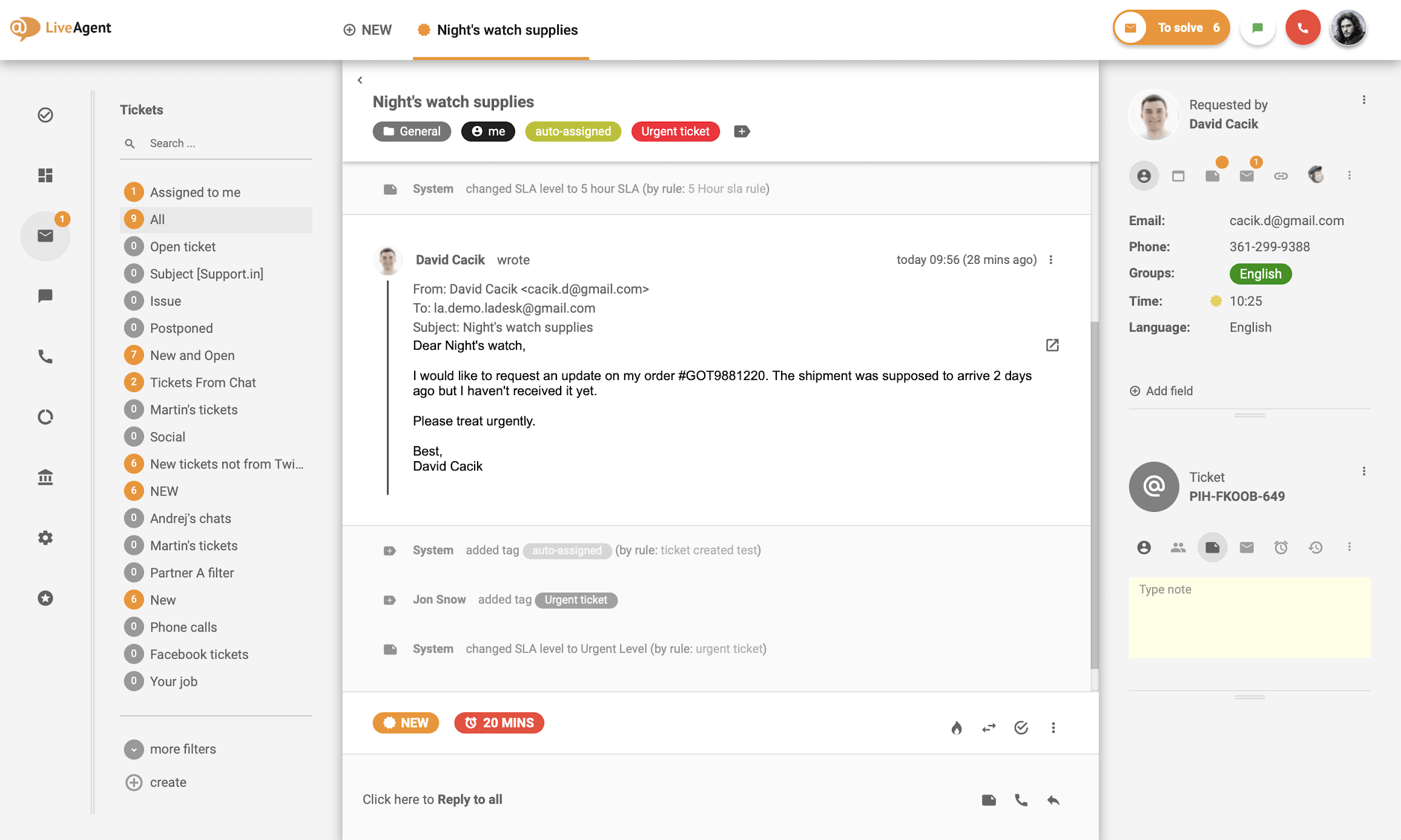
Image Source: LiveAgent
LiveAgent is another impactful tool with a simple and intuitive interface. It offers powerful content authoring tools and customer engagement analytics to manage key elements of your content strategy.
LiveAgent also offers live chat to help you connect with customers instantly. With the real-time typing view feature, you can see what customers are typing in the chat window before they hit send.
Top Features of LiveAgent:
- You can monitor your most responsive channels and their respective ticket volume
- Universal inbox to track and respond to all conversations
- Collision detection prevents multiple team members from sharing duplicate replies
- Automated spam filtering helps keep your inbox organized and junk-free
Pricing:
Starts at $15/agent/month
4. Zoho Desk
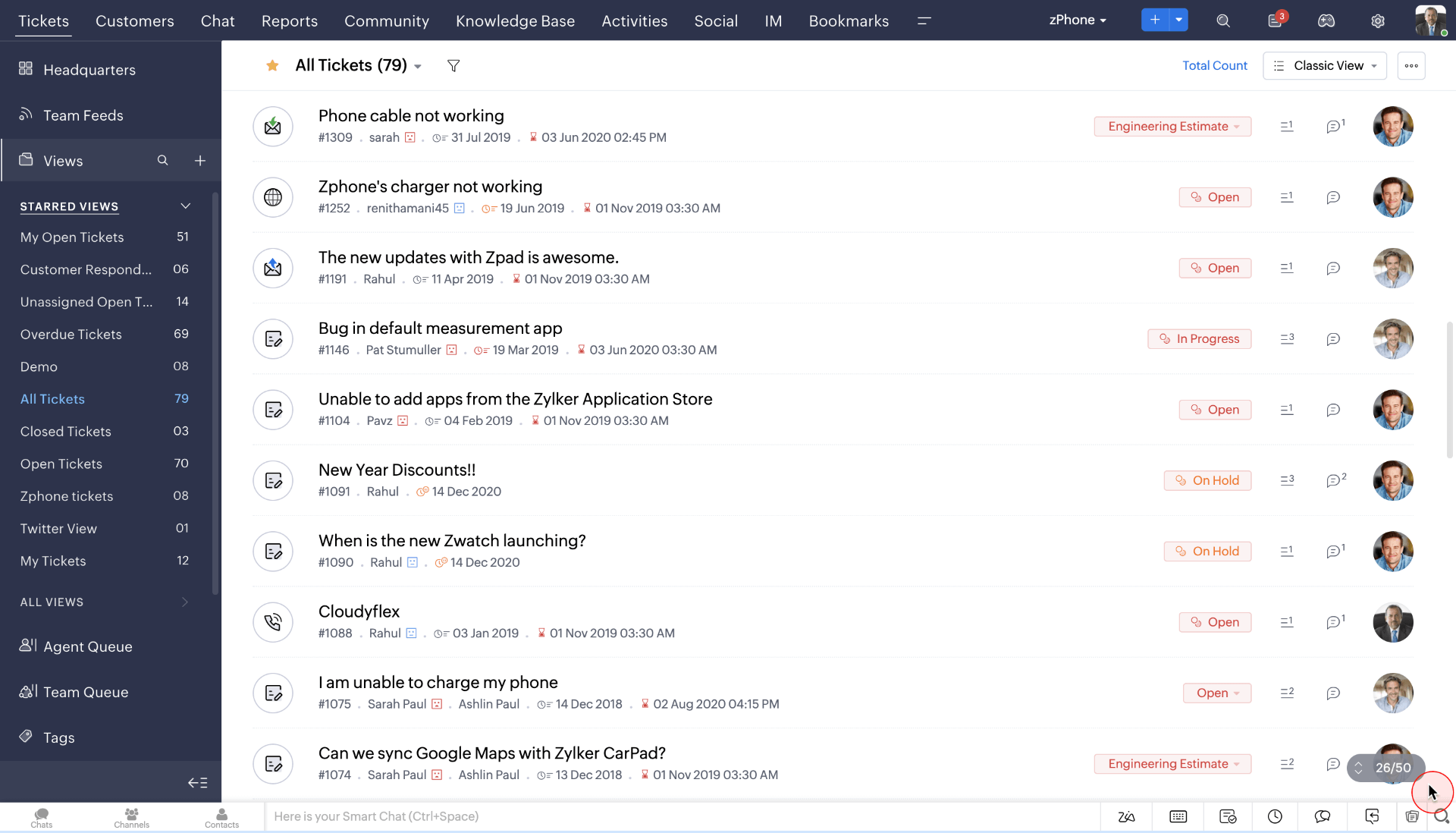
Image Source: Zoho Desk
Zoho Desk offers an omnichannel customer communication management software to transform how your business interacts with customers.
For example, your team can manage customer conversations across various channels, such as live chat, phone, email, social media, and website. Even if you do not have a global team, you can offer 24×7 assistance by creating a dedicated self-service portal.
Top Features of Zoho Desk:
- Ready-to-use templates for emails and ticket forms
- An online community to engage visitors, prospects, and customers
- Intuitive mobile app to stay connected with customers even when on the move
- Zoho CRM integration offers all the customer information you need for personalized assistance
Pricing:
Starts at $14/agent/month
5. Hiver
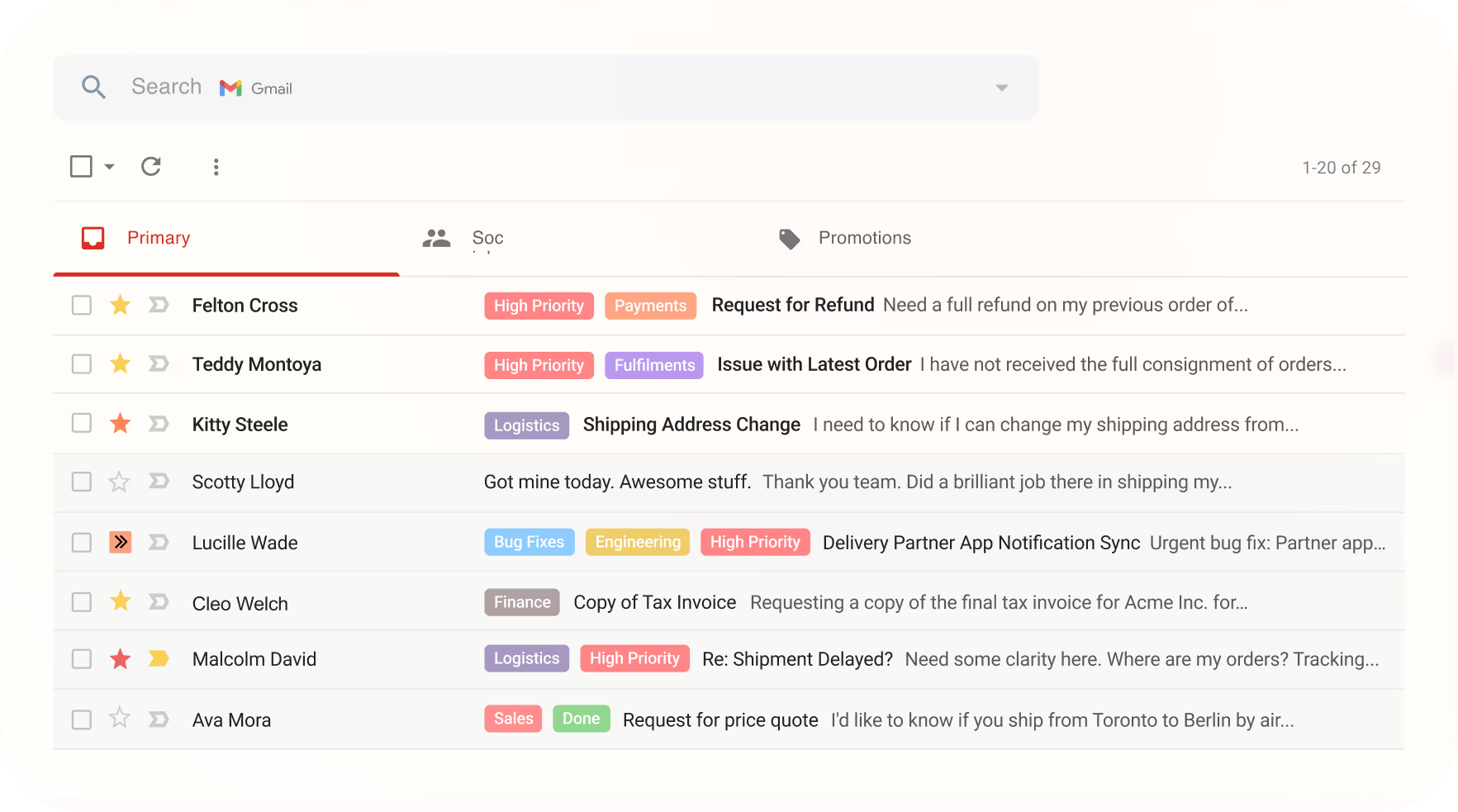
Image Source: Hiver
Hiver integrates seamlessly with Gmail to streamline your customer support processes. Your team can manage customer interactions directly from their Gmail inbox, enabling efficient and effective communication without switching platforms.
Whether it’s handling emails, delegating tasks, or tracking customer queries, Hiver ensures your team stays organized and responsive. In addition to email, this tool lets you connect with customers via live chat and chatbots.
Top Features of Hiver:
- AI Summarizer automatically turns lengthy emails into brief notes
- Email templates for sharing consistent and quick responses
- CSAT surveys to measure customer satisfaction and collect feedback
- Workflows and rules help you automate repetitive tasks
Pricing:
Starts at $19/user/month
Customer Communications Management (CCM) vs. Customer Relationship Management (CRM)
CCM and CRM are closely related, as they both help manage communications between organizations and their customers.
Although many people might use the terms interchangeably, they are not one and the same.
So what’s the difference between CCM and CRM?
- Scope: CCM is primarily about managing the communication itself, focusing on the content and delivery across channels. CRM is broader, encompassing the management of customer relationships, including sales, marketing, and service.
- Functionality: CCM tools are designed for creating and distributing communications, while CRM systems are designed for managing customer data and interactions to improve customer relations and drive sales.
- Use Cases: CCM is used for personalized document creation, multi-channel communication, and compliance. CRM is used for contact management, sales tracking, customer service, and marketing automation.
Win Customers With Improved Communications!
Many businesses struggle to hold meaningful conversations with customers and end up losing them forever.
So what’s the way out? Well, the right customer communication management strategy, when aligned with a robust customer experience strategy, can help you improve the customer experience, keep them informed with proactive notifications, and gain a competitive advantage in the market.
Watch out for trends such as hyper-personalization, increased use of AI-powered chatbots, omnichannel communication, and more. Also, an easy-to-use customer communication management platform like ProProfs Help Desk can help you manage conversations across email, chat, and multiple other channels. Your team can collaborate to solve complex customer issues and leverage AI to share faster replies.
 Tips
Tips
We’d love to hear your tips & suggestions on this article!
FREE. All Features. FOREVER!
Try our Forever FREE account with all premium features!

 We'd love your feedback!
We'd love your feedback! Thanks for your feedback!
Thanks for your feedback!





